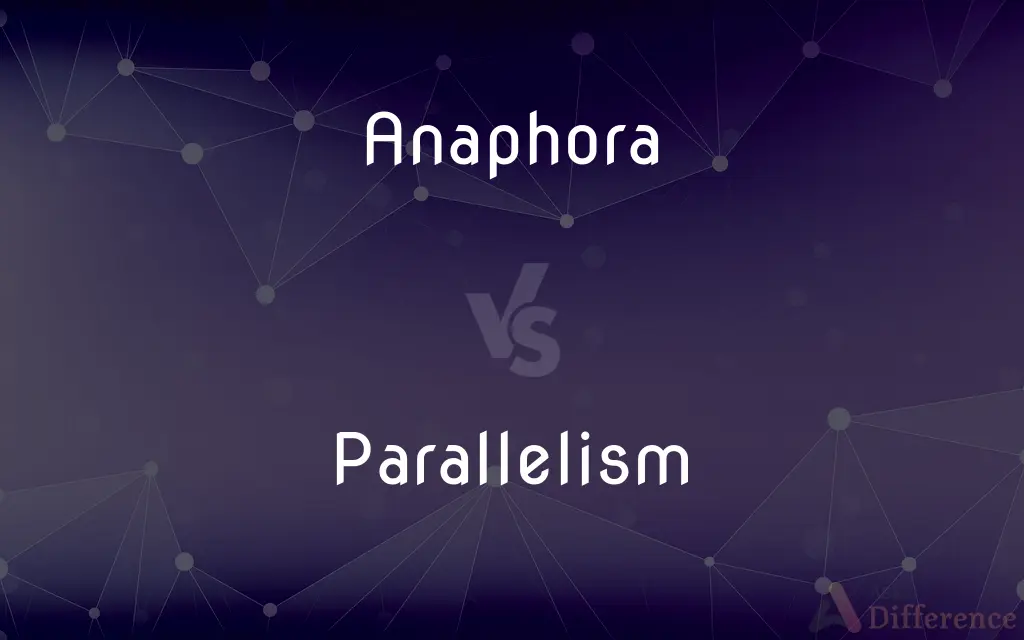Anaphora vs. Parallelism — What's the Difference?
By Tayyaba Rehman — Updated on October 27, 2023
Anaphora is repetition of words at the start of sentences; Parallelism is similar structure in related phrases or clauses.

Difference Between Anaphora and Parallelism
Table of Contents
ADVERTISEMENT
Key Differences
Anaphora involves the repetition of the same word or phrase at the beginning of successive clauses or sentences. Parallelism is the use of components in a sentence that are grammatically the same or similar in construction.
Anaphora creates emphasis and rhythm through repetition at the beginning of phrases. Parallelism focuses on balancing elements in a sentence for clarity and rhythm.
Anaphora is a specific type of repetition used for rhetorical effect. Parallelism is a broader concept that ensures coherence and balance in both prose and poetry.
In anaphora, the repetition of initial words or phrases is its defining characteristic. In parallelism, repetition might occur, but the primary focus is on symmetrical construction.
Anaphora is often found in speeches and persuasive writing for its emotional impact. Parallelism is used in various forms of writing to create a sense of rhythm and symmetry.
ADVERTISEMENT
Comparison Chart
Definition
Repetition at the start of successive clauses
Similar structure in related phrases or clauses
Purpose
Creates emphasis and rhythm
Ensures coherence and balance
Type
Specific type of repetition
Broader concept of symmetrical construction
Primary Focus
Repetition of initial words or phrases
Symmetrical construction
Common Usage
Found in speeches and persuasive writing
Used in various forms of writing
Compare with Definitions
Anaphora
Repetition of the same word at the beginning of sentences.
We shall fight on the beaches, we shall fight on the landing grounds.
Parallelism
Ensuring coherence with grammatical similarity.
The more, the merrier; the fewer, the better fare.
Anaphora
Creating rhythm with repetitive beginnings.
To raise the question, to discuss the topic, to solve the problem.
Parallelism
Using similar structures in related phrases.
She likes reading, writing, and playing.
Anaphora
Enhancing emotional appeal with initial repetition.
Freedom for the oppressed, freedom for the downtrodden, freedom for all.
Parallelism
Creating balance in a sentence with symmetry.
Easy come, easy go.
Anaphora
Emphasizing a point through initial repetition.
Every day, every night, every moment, I think of you.
Parallelism
Aligning sentence components for rhythm.
Like father, like son; like mother, like daughter.
Anaphora
The deliberate repetition of a word or phrase at the beginning of several successive verses, clauses, or paragraphs; for example, "We shall fight on the beaches, we shall fight on the landing grounds, we shall fight in the fields and in the streets, we shall fight in the hills" (Winston S. Churchill).
Parallelism
The quality or condition of being parallel.
Anaphora
(Linguistics) The use of a linguistic unit, such as a pronoun, to refer to the same person or object as another unit, usually a noun. The use of her to refer to the person named by Anne in the sentence Anne asked Edward to pass her the salt is an example of anaphora.
Parallelism
Correspondence or similarity.
Anaphora
(rhetoric) The repetition of a phrase at the beginning of phrases, sentences, or verses, used for emphasis.
They didn't speak. They didn't stand. They didn't even look up when I came in.
Parallelism
(Grammar) The use of identical or equivalent syntactic constructions in corresponding clauses or phrases.
Anaphora
(linguistics) An expression that can refer to virtually any referent, the specific referent being defined by context.
Parallelism
(Philosophy) The doctrine that to every mental change there corresponds a concomitant but causally unconnected physical alteration.
Anaphora
(linguistics) An expression that refers to a preceding expression.
Parallelism
The state or condition of being parallel; agreement in direction, tendency, or character.
Anaphora
(Christianity) The most solemn part of the Divine Liturgy or the Mass during which the offerings of bread and wine are consecrated as body and blood of Christ
Parallelism
The state of being in agreement or similarity; resemblance, correspondence, analogy.
Anaphora
Plural of anaphor
Parallelism
A parallel position; the relation of parallels.
Anaphora
A repetition of a word or of words at the beginning of two or more successive clauses.
Parallelism
The juxtaposition of two or more identical or equivalent syntactic constructions, especially those expressing the same sentiment with slight modifications, introduced for rhetorical effect.
Anaphora
The use of a substitute word, such as a pronoun, in reference to a something already mentioned in a discourse; also, the relation between the substitute word and its antecedent. It is contrasted with cataphora, the use of a pronoun for a word or topic not yet mentioned.
Parallelism
(philosophy) The doctrine that matter and mind do not causally interact but that physiological events in the brain or body nonetheless occur simultaneously with matching events in the mind.
Anaphora
Using a pronoun or other pro-word instead of repeating a word
Parallelism
(legal) In antitrust law, the practice of competitors of raising prices by roughly the same amount at roughly the same time, without engaging in a formal agreement to do so.
Anaphora
Repetition of a word or phrase as the beginning of successive clauses
Parallelism
(biology) Similarity of features between two species resulting from their having taken similar evolutionary paths following their initial divergence from a common ancestor.
Anaphora
A rhetorical device using repeated words at the start.
My life is my purpose, my life is my goal, my life is my inspiration.
Parallelism
(computing) The use of parallel methods in hardware or software, so that several tasks can be performed at the same time.
Parallelism
The quality or state of being parallel.
Parallelism
Resemblance; correspondence; similarity.
A close parallelism of thought and incident.
Parallelism
Similarity of construction or meaning of clauses placed side by side, especially clauses expressing the same sentiment with slight modifications, as is common in Hebrew poetry; e. g.: -At her feet he bowed, he fell:Where he bowed, there he fell down dead. Judg. v. 27.
Parallelism
Similarity by virtue of correspondence
Parallelism
Achieving clarity through structural similarity.
He wanted to have a new house to live in and a new car to drive.
Common Curiosities
What is the purpose of parallelism?
The purpose of parallelism is to create balance and coherence in writing.
How does anaphora create emphasis?
Anaphora creates emphasis through rhythmic repetition at the start of phrases.
What is anaphora?
Anaphora is the repetition of words at the beginning of successive sentences or clauses.
Does anaphora always involve repetition?
Yes, anaphora specifically involves the repetition of initial words or phrases.
Can parallelism improve readability?
Yes, parallelism can make writing more readable and memorable.
Why is anaphora powerful in speeches?
Anaphora is powerful in speeches due to its emotional impact and rhythmic quality.
What is parallelism?
Parallelism is the use of similar structures in related phrases or clauses.
Can anaphora be found in poetry?
Yes, anaphora is often used in poetry for its rhythmic and emphatic effects.
Is anaphora a type of parallelism?
Anaphora is a type of repetition, while parallelism is about balanced structure, so they are related but distinct.
Is parallelism used in speeches?
Yes, parallelism is used in speeches to enhance clarity and impact.
Are anaphora and parallelism only used in English?
No, these rhetorical devices are used in many languages.
Can parallelism be used in everyday language?
Yes, parallelism is often used in everyday language to express ideas clearly and memorably.
Can anaphora be used in prose?
Yes, anaphora can be effectively used in prose, especially persuasive writing.
How does parallelism affect rhythm?
Parallelism creates a sense of rhythm through symmetrical construction.
Does parallelism always involve repetition?
Parallelism may involve repetition, but its focus is on structural similarity.
Share Your Discovery

Previous Comparison
Herbalist vs. Herbologist
Next Comparison
Celebrated vs. FamousAuthor Spotlight
Written by
Tayyaba RehmanTayyaba Rehman is a distinguished writer, currently serving as a primary contributor to askdifference.com. As a researcher in semantics and etymology, Tayyaba's passion for the complexity of languages and their distinctions has found a perfect home on the platform. Tayyaba delves into the intricacies of language, distinguishing between commonly confused words and phrases, thereby providing clarity for readers worldwide.














































